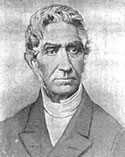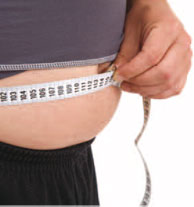Adolphe Quetelet
 Adolphe Quetelet was one of the most influential figures in social statistics of the 19th century and an important contributor to social sciences in Europe. He was born on 22 February 1796 in Ghent (Belgium). He received a doctorate in mathematics in 1819 from the University of Ghent. At his urging, a census of the population was taken in 1830 in the former Netherlands. He applied his knowledge on statistics on the results of the census and developed the concept of ‘the average man’, who is characterized by the mean values of measured variables that follow a normal distribution. The formula behind this concept became known as the Quetelet Index or Body Mass Index.
Adolphe Quetelet was one of the most influential figures in social statistics of the 19th century and an important contributor to social sciences in Europe. He was born on 22 February 1796 in Ghent (Belgium). He received a doctorate in mathematics in 1819 from the University of Ghent. At his urging, a census of the population was taken in 1830 in the former Netherlands. He applied his knowledge on statistics on the results of the census and developed the concept of ‘the average man’, who is characterized by the mean values of measured variables that follow a normal distribution. The formula behind this concept became known as the Quetelet Index or Body Mass Index.
The Quetelet Index or Body Mass Index
The Body Mass Index (BMI) is a simple measure for classifying people's weight relative to an ideal weight for their height. A BMI greater than 25 is considered overweight and above 30 is considered obese (excess body fat with an adverse effect on health). Excessive body fat has negative health implications on cholesterol levels, blood pressure and sugar levels (increased risk of Diabetes Type II). BMI is measured by taking a person's weight and dividing it by their height squared.
Body Mass Index = body weight (pounds) / height (inches)2 * 703
Restrictions
There are some restrictions for using the BMI calculation, as the values do not take into consideration muscle mass or body frame size. The tool should therefore not be applied to children, pregnant women, athletes or people with an exceptional constitution. BMI is a good screening method for weight categories but it is not a diagnostic tool. You should not jump to any conclusions based on the outcome of the calculation.
Calculate your BMI (for adults)
Note: Our BMI calculator is not a source of clinical guidance and it is not a substitute for any professional medical advice. Because BMI is based on weight and height, it is only an indicator of body fatness. Individuals with the same BMI may have different amounts of body fat. Persons may consider seeking advice from their healthcare providers on healthy weight status.
Apple- versus pear-shaped body

There are several methods to measure your body fat percentage such as the skin fold method, the anthropometric method (body circumference measurements) or the bioelectric impedance analysis (opposition to the flow of an electric current through your body). Women store fat differently from men.
They tend to have more subcutaneous fat (right beneath the skin) around the hips, thighs and buttocks. Excess fat will be stored in those areas, hence the pear shape. Men, on the contrary, usually store excess fat in the abdominal region creating an apple-shaped body. This type of fat is called visceral fat as it surrounds the internal organs. It is generally thought that there are more health risks for the apple-shaped body. To determine your body shape, you need to measure your waist-to-hip ratio. If in women the ratio between the hips and waist is bigger than 0.85, the body is pear-shaped. If in men the ratio is bigger than 1, the body is apple-shaped. Men should worry about increased health risks if the size of their waist is larger than 40 inches, women if their waist is larger than 35 inches.